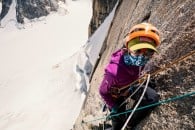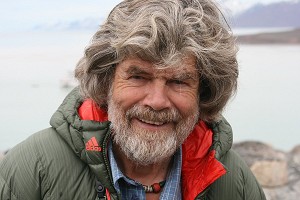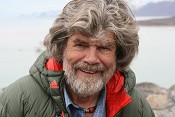
A National Geographic team led by Free Solo director Jimmy Chin believe they have discovered the remains of British mountaineer Andrew 'Sandy' Irvine, the youngest member of the 1924 expedition who disappeared aged 22 one-hundred years ago along with climbing partner George Mallory. An exclusive article reports that filmmaker and climber Erich Roepke spotted a foot, boot and sock labelled 'A. C. Irvine' emerging below the North face of Mount Everest on the Central Rongbuk Glacier in September while conducting a search for Irvine's remains.
On June 8th 1924, Irvine and Mallory were last sighted 'going strongly for the top' by leader Noel Odell near the Second Step, just three-hundred metres below the summit. As they disappeared into the clouds, they were never seen again. The question of whether they reached the summit or not — almost 30 years before Tenzing Norgay and Edmund Hillary's celebrated first ascent — remains one of the most enduring mysteries in the realms of mountaineering and exploration.
In 1999, American mountaineer Conrad Anker discovered the remains of George Mallory at 8,156m during a Mallory and Irvine Research Expedition. His snow goggles were in his pocket, suggesting that the pair fell at night during their descent. Adding to the intrigue, a photo of Mallory's wife Ruth, which he had promised to leave on the summit, was not present. Markings across his body suggested that the pair fell while roped together, but the location of Irvine remained unknown. Finding Irvine's remains, and with them, the Kodak Vest Pocket Camera that he carried up the mountain, could help to determine whether or not they summited.
Over the years, theories circulated as to why Irvine's body had not been found. British climber Frank Smythe had spotted a body high on the mountain through a telescope in 1936, which he believed could only have been either Mallory or Irvine. Members of a Chinese expedition in 1960 reported sightings of a body at 8,600m. One theory by mountaineer and author Mark Synnott posited that Chinese climbers had since found and removed Irvine's body and camera.
Last month, the National Geographic team led by Jimmy Chin were searching for Irvine's body and found an oxygen cylinder from 1933 - nine years after Mallory and Irvine's disappearance. Estimating that the bottle would have fallen further than a body, Chin and his team narrowed their search field to an area closer towards the mountain. Members of the 1933 expedition had found Irvine's ice axe on the northeast ridge, but far below where Mallory's body was located.
Following his fortuitous find, Chin told National Geographic that he believes the boot melted out of the glacier only a week or so before they spotted it. "I lifted up the sock and there's a red label that has A.C. IRVINE stitched into it," he told National Geographic. "We were all literally running in circles dropping F-bombs." He added that the find "certainly reduces the search area" for locating the rest of Irvine's remains, and potentially his camera.
Born in Cheshire, Irvine was the youngest member of the 1924 expedition at age 22 and had studied at Oxford University, where he was a competitive rower. Although he lacked climbing experience, Irvine was chosen for the expedition and eventually the fateful summit bid in light of his physical fitness and engineering skills. He was appointed oxygen officer, having designed bespoke cylinders for the team — a role which is believed to have aided his selection to accompany the more seasoned Mallory to the summit after two previous failed attempts.
Julie Summers, Irvine's great-niece and biographer who published Fearless on Everest: The Quest for Sandy Irvine in 2001, was the first relative to be informed of the find.
"It's an object that belonged to him and has a bit of him in it," she told National Geographic. "It tells the whole story about what probably happened. I'm regarding it as something close to closure."
Irvine's family members have agreed to provide DNA samples to assist in verifying the remains.
















Comments
A little more background information of what happened 100 years ago, deductions that have been made as more is revealed from the icy snows on Everest. I conclude with my own personal thoughts. I apologise if there are any mistakes, but there is a lot of conflicting evidence and biased opinions out there. See...
https://seansmountaincamera.blogspot.com/2024/10/mallory-irvine-well-did-they-or-didnt.html
I think the problem is more the lack of evidence rather than conflicting evidence. In the absence of anything concrete there are all sorts of theories that can be made to fit. I went down the rabbit hole last weekend and there seem to be an awful lot of people expressing far more certainty than the evidence supports.
A good example of confusing detail are the oxygen bottles being analysed to prove they got to the top. But the only proven bottle found is bottle no 9, and that 100 metres or so above the first step by Jochen Hemmleb in 1999. Now an 1924 number bottle on the summit would be a game changer, but unfortunately none has been found this high. Altogether most of the oxygen bottles from the 1924 Expedition leaked very badly and only 5 were usable and carried up to Camp VI.
Another confusing issue is that Grayson Schaffer in his National Geographical article states that 4 Chinese mountaineers saw the body of a prewar British climber high on Everest, but only two climbers have been identified. also the description of the body is described differently, one describes 'a huddled figure' and another describes a figure in his sleeping bag. So certainly not Mallory. But then why has Mallory got rope-burns around his torso? Surely Irving must have fallen and the weak hemp rope has obviously snapped, suggesting that Irving has gone a long way. Indeed his recent remains have been found on the Rongbuk glacier. So the Chinese descriptions do not make sense. Did he slip because he had absentmindedly left his axe behind during the exhausting descent? It was found resting on a ledge just below the ridge in 1933 by Wyn Harris. It was clearly marked with Irving's signature three stripes. All this is conjecture of course, until more evidence surfaces.
'Saboteurs' 1924 expedition...
Oh, and Irvine in your second post...
Thanks. Not sure if some of the spelling is the confusion between US & UK English. For example the US uses z instead of standing in lots of word endings. Very annoying when your spellchecker let's them pass unnoticed.